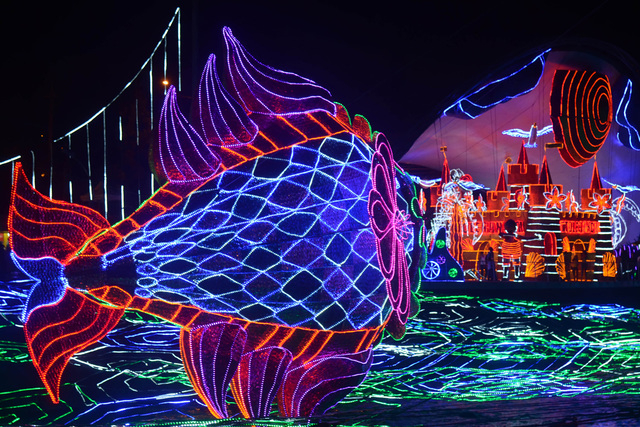Medellin now known for Christmas lights, not drugs

MEDELLIN, Colombia — Medellin for Christmas vacation? Si, si!
The city once wracked by drug violence has undergone massive social and economic transformation, and it’s now known in tourist circles for spectacular Christmas light displays that veil churches, buildings, parks and even the Medellin River with glittering cascades of color.
The spectacle can be seen in neighborhoods around the city every night through Jan. 12 from 6 p.m. to 1 a.m. It draws an estimated 4 million visitors, including thousands of tourists. The scene feels like a carnival, with crowds of families on foot gazing in awe, street vendors and long lines of cars and tour buses streaming slowly by.
The displays change each year and are created by EPM, a state utility company that derives much of its power from hydroelectric sources. The company, which also produces light displays in the Colombian cities of Cali and Quimbaya, held an open call for ideas for the light shows, resulting this year in more than 1,500 suggestions. The lights can be seen primarily in eight areas of the city: Cerro Nutibara, La Playa Avenue, East Avenue, Carabobo, San Juan, Junin, 70 North Street and Las Palmas. Each area’s display has a different theme, for example animals, symbols of peace, flowers and Christmas trees.
Locals are quick to remind visitors that perceptions of the city as a center of drug violence are outdated. After all, Colombia’s most notorious outlaw, drug kingpin Pablo Escobar, was assassinated more than 20 years ago. While it’s possible to find tour guides offering “Escobar tours” of Medellin that include a stop at the building where he was ambushed by police, tour guide Andres Munera prefers to focus on more positive themes, from the Christmas lights to excursions to nearby coffee farms and nature reserves.
Munera, 43, a native of Medellin, started his business, Land Venture Travel, in 2010, and says about 50 percent of his customers are American. After all, “it’s just a three-hour flight from Miami,” he said. He credits Alvaro Uribe, who served both as Colombia’s president and Medellin’s mayor, with helping change Colombia’s reputation, and says life in Medellin has been transformed by everything from libraries and parks to assistance for entrepreneurs.
Despite economic and social strides in Medellin and elsewhere, challenges remain. Medellin has recently been in the news over reports of underage prostitution, and the taxi industry in the capital, Bogota, is plagued by robberies.
But tourism is on the rise. In 2013, about 1.7 million tourists visited Colombia, more than three times the number that visited in 2002. About 20 percent of 2013 arrivals, or 343,891, were from the U.S., up slightly from the previous year. Tourism from the U.S. is expected to grow with the recent addition of direct flights on Avianca from New York.
Munera says the improved quality of life, along with social media and word of mouth, is helping persuade tourists to visit. “We don’t do Pablo Escobar tours because that evil man was the worst thing that has ever happened to Medellin and the entire country,” Munera said. “We prefer to focus on the positive present than on a painful past.”